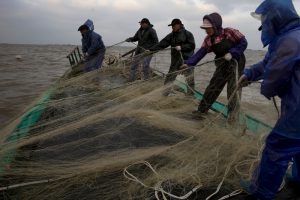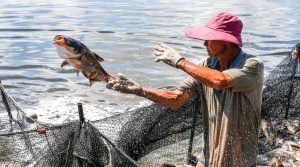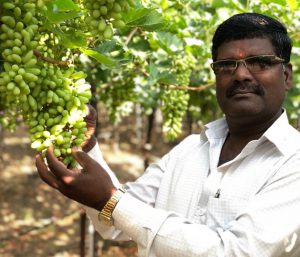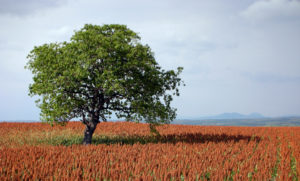In 1986, China passed its Fisheries Law, privatising fishing vessels and unleashing a massive expansion in the fleet. Today one in four fishing vessels in the world is Chinese. Most are fishing off China’s coast, leading to a significant problem with overfishing. But the ocean, and the resources it holds, is shared by everyone. What is China’s place in the global network of policies regulating the world’s fisheries? And what is the country trying to do to break the cycle of overfishing?
Guests
- Margot Stiles, Oceana
- Dr Yvonne Sadovy, The University of Hong Kong
- John Mimikakis, Environmental Defense Fund
More from this series
Podcast: The history of overfishing in China
Podcast: China’s massive aquaculture industry
Podcast: Marine ranching off China’s coast
Transcript
Marcy Trent Long: Hi! My name is Marcy Trent Long. Welcome to Sustainable Asia.
1986 is made in collaboration with chinadialogue. It’s a four-part podcast series about China, oceans and fish.
In our last two podcast seasons, we looked at different ways to stem the tide of plastic pollution going into our oceans from China and Asian countries. Now, we’re turning our lens to another ocean-related problem: overfishing. China is the largest exporter and importer of seafood products in the world. But it wasn’t always that way.
In 1986, China passed a Fisheries Law that privatised fishing vessels and moved China from a country of wooden boat fishing communes into the modern world of mechanised, commercial fishing trawlers. The reforms were so effective that it created a nearly catastrophic state of overfishing that China is now coming to terms with.
Vox Pop 1: I think overfishing is you keep hunting the fish and do not have a limit.
Marcy: That’s pretty much what happened in China over the last 30 years.
Vox Pop 2: It’s that the fishermen are overfishing and they catch all the fish in the sea and they cannot continue their reproduction.
Vox Pop 3: Overfishing is the phenomenon where the ecosystem of the fishes is disturbed, which reduces their populations dramatically.
Marcy: Here in Hong Kong, we’re one of the biggest consumers of seafood per capita in the world. Wealthy island and full of people that love all seafood imaginable. It’s encouraging that young people who I interviewed understand the problem of overfishing. But I’m not sure if any of us know what to do about it.
Margot Stiles: So the solution to overfishing initially seems quite simple. Basically, you have to count up the fish and estimate how many babies they have in a year and then make sure that you’re taking out fish at the same rate that they’re being produced, or a little bit less.
Marcy: Margot Stiles is chief of strategy at Oceana, an international organisation that works to save the oceans and feed the world. That’s a big task. But it gets broken down this way: Oceana works to make fisheries more productive, help protect the habitat for fish nurseries and reduce overfishing. Sounds challenging? It is.
Margot: Then the next step is to figure out and decide on a limit – a catch limit. So every year we’re going to catch 100 fish and not 200, or something like that. So after the government has figured out how many fish there are and decided how many to catch, then implementing it with all the different people that are participating; that can be kind of the hardest part. So almost all of that happens at a national level.
Marcy: OK, overfishing seems to be a national, country by country problem. But the ocean is shared by all of us.
Margot: Because fish swim all over the world, that’s where it gets really challenging. So I think there aren’t that many things that are shared globally, and there is certainly no other food that is traded globally, as much as seafood.
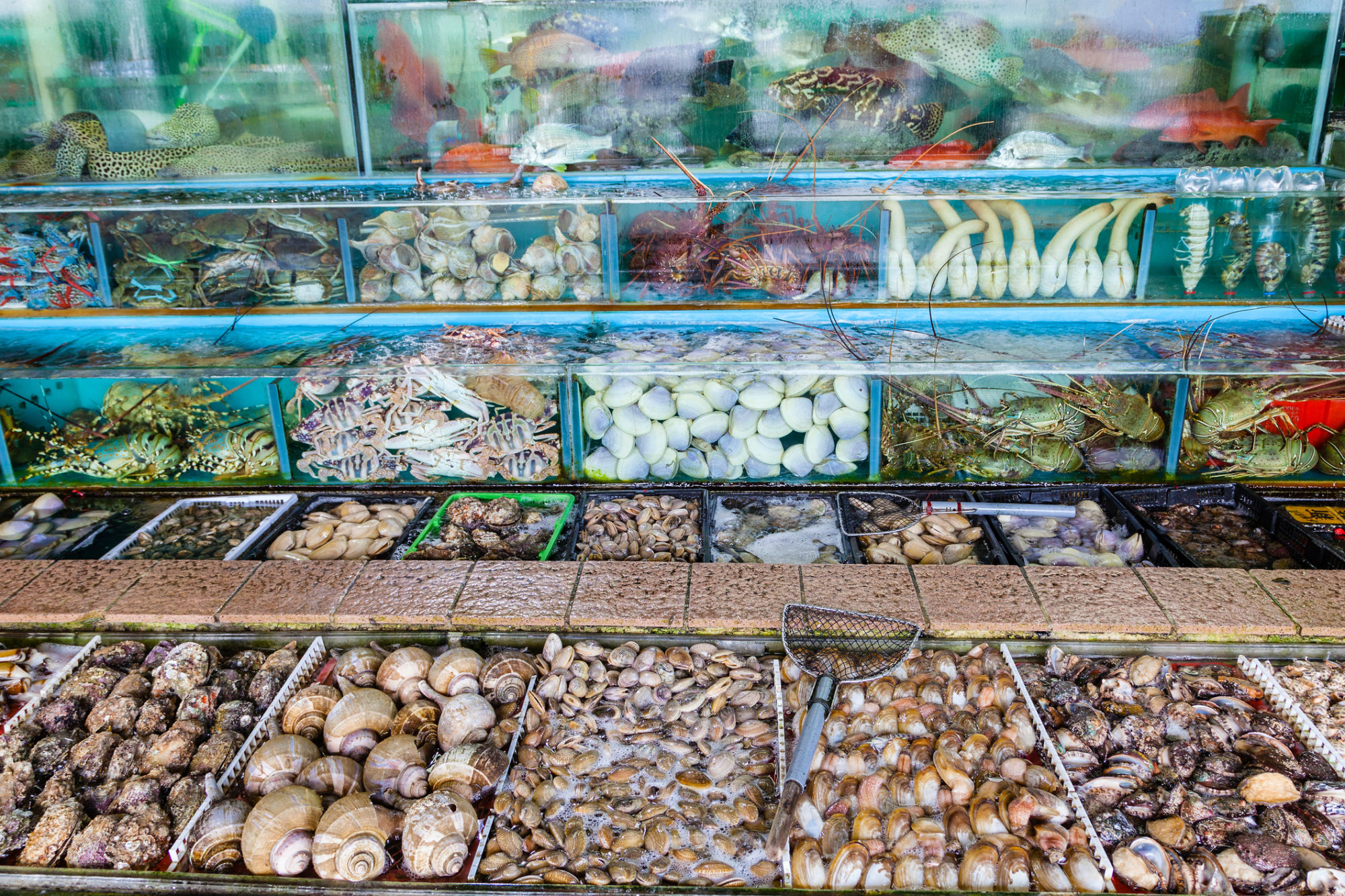
Marcy: Managing overfishing in the global oceans is actually a relatively recent phenomenon that started as fishing technology became more advanced and frighteningly efficient.
Yvonne Sadovy: My name is Yvonne Sadovy and I’ve been working at the University of Hong Kong in the Biology Department – I’ve been here for 25 years.
Marcy: Dr Sadovy initially worked in the Caribbean and Puerto Rico, then found her home in Hong Kong. While most of us have really only thought about our impact on the ocean recently – with social media pictures of beached whales and Q-tip-laced seahorses – Dr Sadovy has spent her career researching marine issues. I tracked her down in her office to understand how different countries govern the use of the ocean.
Yvonne: We really started to industrialise fishing after the Second World War, I would say.
And as that fishing increased, I think countries began to recognise the need to have some way of defining how we use the ocean, and maybe what our obligations were towards the ocean, to protecting it, or to manage it, for example. So the United Nations developed over many years – it took a lot of debate – something called the Law of the Sea, which was ratified several decades ago – ratified being a lot of different countries had to agree to it to put it into place internationally. And that is now recognised internationally. And what that does is, it allows each country that has a coast jurisdiction out to 200 nautical miles. Lot of debate about that if you’ve got countries closer than 400 nautical miles of course, but the law is out to 200 nautical miles. And amongst many other things, there are two key components to this law. One is that each of those coastal countries has the right to exploit those resources out to their exclusive economic zone limit, the 200 mile zone, but they also have a commitment and an expectation that they will manage those resources sustainably. So it’s a right of access, but it’s also an expectation that you will look after those resources.
Marcy: China took part in the negotiations for the UN Law of the Sea Treaty from 1973-1982, which led to China’s first Fisheries Law in 1986. But China didn’t actually ratify the treaty until 1996.
Yvonne: So how do we manage resources inside the economic zone? There are regulations – each country will have its own regulations, its own legislation, its own laws… But there are some guiding principles, which have been developed by the Food and Agriculture Organization of the United Nations, and they were developed in 1995, so shortly after the Law of the Sea came into effect. And they’re very comprehensive. It’s a set of guidelines for how to conduct mariculture, or fish farming for example, how to manage your resources… And these guidelines can be adapted by different countries to fit their local circumstances. So we have now these guidelines and these international regulations, which really help to shape the way in which we can and should be managing these marine coastal resources.
Marcy: According to estimates, 85-90% of all fish that are caught in the open ocean are actually caught in the EEZ, the Exclusive Economic Zones of individual countries. So those great videos of trawlers out on the high seas catching massive volumes of fish? Those could easily have been taken from within the EEZs and been complying with local fishery laws.
So here’s a question: what happens to migratory fish that swim in and out of the EEZs?
Margot: What distinguishes them is how far the fish swim. So some fish like to stay at home and they basically have their rock, and they’re like, this is my rock and this is my home and I don’t go anywhere. So really, those kinds of fish, the people that live right near them are controlling whether they’re overfished or not. But then you have tuna, which basically will travel all over the planet. And so a tuna fish, that’s something that many countries have to agree on how many tuna and who’s going to get the tuna.
Marcy: Margot Stiles again.
Margot: I think there is a global overfishing problem, which is when you add up all the fisheries and all the different countries, many of them have a lot fewer fish than they had in the past. But then when you try and solve that problem, it quickly becomes more of a regional problem, not a country-specific problem.
Marcy: And China is discovering this as the battle for fishing rights in the South China Sea escalates. The overfishing dilemma inflames political tensions over who has fishing rights where the 200 [mile] EEZs intersect. China and Vietnam recently gathered to review the Vietnam-China Fisheries Cooperation Agreement, which defines how each country will protect, manage, use and exploit the natural resources of this overlapping EEZ in the South China Sea. But as large commercial fishing trawlers start to move away from their coastlines and EEZs in search of more fish, what happens?
Margot: Many countries, particularly China and Spain, Japan, Korea, have large international fleets. But those fleets are probably the most poorly regulated, because they are roving around in remote areas. And there’s not actually really good international governance on fisheries. All that space out in the middle of the ocean is basically neutral, it’s kind of a free for all. And human beings don’t tend to do well in that kind of regulatory environment.

Marcy: The UN Food and Agriculture Organization has created guidelines, but there’s still no formal agreement to managing the open ocean and its resources. And we are talking about fishing in this episode. But what about sharing the seabeds and mining in the open ocean? Antarctica? Clearly a subject for later seasons.
For migratory fish species, there are some international agreements that allocate each country’s rights to fish species like sharks, swordfish and all kinds of tuna. So what happens in Asia?
Yvonne: So if we just focus on the Asian region, and I guess I would have to say maybe we’re talking about Southeast Asia, the East China Sea, South Asia… So it’s a very large area. And this area is very productive from a fishery perspective. I think it’s sort of either the fourth or fifth most productive region in the world. So it’s very, very important. It’s incredibly important as a food source and a source of livelihood.
Marcy: Yvonne Sadovy again.
Yvonne: I would say that over the last two to three decades, there have been some big changes in the region and the condition of the fishery. And those changes have occurred because of a big increase in fishing. In other words, a lot more boats, a lot more horsepower, a lot more fishermen… fishing gears have become a lot more efficient, etc. So that has really intensified the fishing activity and increased the ability to remove fish. And the projection is that if nothing is done, we’re going to lose 50-60% of the food, of the livelihoods, all the income and benefits associated with these fisheries, which is very, very serious for the countries in the region. So there is a real need to do something – to do fishery management, to do fishery improvement in some kind of way – in the region, if we’re not to lose those benefits.
Marcy: There’s a movement to make fishing practices in the South China Sea more transparent. I earlier mentioned the Vietnam-China Fisheries Cooperation Agreement. Now the Philippines, China and Vietnam are also considering signing a common fishing agreement on the disputed Scarborough Shoal in the South China Sea. So that’s progress on clarifying limits and rules for fishing in the open sea. But more work needs to be done.
John Mimikakis: I’m an ocean conservationist at the Environmental Defense Fund. My name’s John Mimikakis and I lead our effort to make oceans sustainable in Asia.
Marcy: John now lives in Singapore and is helping reshape fishery policies throughout Asia. He’s become an expert advisor to China on fishery policies.
John: China’s leaders recognise that overfishing is a problem. They know that it’s undermining the country’s economic interests. And that’s why the last five year plan, the 13th Five Year Plan, calls for reforms in many of China’s natural resources, including its marine natural resources. Top leaders today in China are pushing for a number of improvements in managing fisheries sustainably. I think in my opinion, most interestingly, they’re also experimenting in trying to apply some of the best practices that other countries have developed in adapting those practices in the Chinese context.
Marcy: So China is not only working through overfishing issues with their neighbours in the South China Sea, they are also looking at the 1986 Fisheries Law and how to break the cycle of overfishing that it has unleashed in their traditional coastal fishing grounds. But as we discussed in the previous season of Eight Million, China often has solid environmental policies at the national government level, but implementing those policies all the way down through 23 provinces, over 1,300 counties and 1.4 billion people can be complicated.
In the next episode, we will look at the history of fishing in China from the Han Dynasty to present day. There is a reason why Chinese refer to the cradle of their civilisation as the home of fish and rice – fish is interwoven with the culture and livelihood of a people that count their origins back over 2,000 years. Next, on episode two of 1986.
Special thanks to our sponsors, the Swire Group Charitable Trust – creating positive change in education, marine and arts through supporting registered non-profit organisations, primarily in Hong Kong and mainland China.
1986 is produced by Sustainable Asia in collaboration with China Dialogue. The season was created and written by me, Marcy Trent Long. The assistant producer was Li-Ting Lin. Special thanks to Oscar Lee, John Mimikakis, Sam Bekemans, Jill Baxter and Zhang Chun. Carson and Kinsey Long created the 1986 graphic. And the intro and outro music is made from repurposed and recovered waste items by Alexander Mauboussin. Learn more about his music at kalelover.net.
Let’s not forget a warm thank you to our voice-overs: Kinsey Long, Annabat Martens, Ethan Chen and Andrew Suckley.
If you like what you hear, subscribe to the Sustainable Asia podcast. And please give us a rating.
